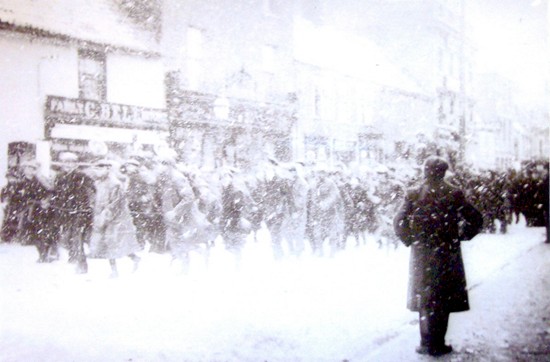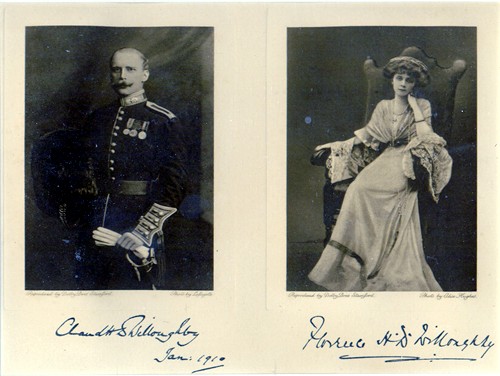|
The General Election of 1910
One of the most exciting Parliamentary contests of the last century was the fight for a seat to represent the South Kesteven or Stamford division of Lincolnshire which also included Bourne. It took place in January 1910 and was particularly noteworthy in that it coincided with the emergence of the Conservative Unionist party as a major political force but also because motor cars in large numbers were used for the first time as a vital asset in getting people to the polling booths. The election was a straight fight between the Conservative candidate, Major the Hon Claud Willoughby, son of the first Earl of Ancaster, of Grimsthorpe Castle, Bourne, an officer with the Coldstream Guards, who was fighting his first general election following the retirement of the sitting member, Lord John P Joicey-Cecil, and the Liberal candidate, Mr G H Parkin. Britain then had a Liberal government under the premiership of Herbert Asquith but the Conservatives were intent on change and in the event there was a dead heat between the two main parties and they won 273 seats, the same number as the Liberals who retained power with the support of Labour which won 42 seats, while the Nationalists took 82 seats. At that time, the constituency was quite large, extending from Beckingham in the north to Crowland in the south, a distance of almost 60 miles by road, and 27 miles from east to west and containing over 150 parishes. The number of eligible voters was 10,056 and there were 35 polling centres where they could cast their votes. Polling day was fixed for Friday 28th January and the Corn Exchange at Bourne was chosen as the venue for the count. Many cars were placed at the disposal of the candidates and Major Willoughby alone had more than 100 running in all parts of the constituency, loaned by friends and relatives such as the Duke of Rutland, the Marquess of Exeter, the Earl of Ancaster, Earl Brownlow, the Earl of Londesborough and Lady Greenall. Candidates were up and early on General Election day but there was one factor against them and that was the weather. During the night, there had been a heavy snowfall which had settled to a depth of several inches in many places, Stamford and Bourne being particularly affected, while the forecast was for more of the same, thus preventing voters in outlying districts from reaching the polling booths and, worse still the snow also impeded the progress of the motor cars. At eight o’clock, Major Willoughby set out by car from Grimsthorpe with his wife, Lady Florence, and began a tour of the constituency. His opponent, Mr Parkin, who had been staying at the George Hotel at Stamford, also left early for a similar trip with his wife, the candidates being cheered en route by supporters with a profuse display of the political colours and despite the wretched weather, both candidates managed to keep well within their scheduled times. The effect of the snow on the cars, however, was early in evidence, one vehicle running for the Liberals breaking down and had to be towed away by another and conditions were so bad in some areas that several electors experienced the novelty of being taken to the polls on a sledge. The only incident of an unpleasant nature occurred at Stamford where Mr Parkin was struck in the face by a piece of frozen snow and received a slight injury and the Stamford Mercury reported enigmatically: “This attack was much regretted on all sides, especially in the Bourne district, where an alarming report had been circulated.” The count took place the following day under the supervision of Mr J N Scorer, the Under-Sheriff of Lincolnshire, when the Corn Exchange at Bourne was packed for the occasion. Both candidates were present with their wives and among others who watched the proceedings were the Marchioness of Exeter, Mr Arthur Priestley MP, Mr A W Dean (chairman of the South Lincolnshire Conservative and Unionist Association), Mr H Daniels, of Stamford (the Liberal agent), Mr A E Dixon, of Bourne (the Conservative agent), Mr J Thurlby, of Baston, Mr G Smith, of Horbling, Mr R G Evans and Mr James Dalton, of Stamford. “The work of counting was expeditiously carried out, thanks to the excellent arrangements made by the Under-Sheriff and his staff”, reported the Stamford Mercury. The result was: Major the Hon C H D Willoughby (C) 4,666 The victor proposed a vote of thanks to the returning officer and Mr Parkin, in seconding, remarked that he had only been beaten by the out-voters. The turnout was 85%, regarded in those days as a comparatively light poll, and a large crowd gathered outside the Corn Exchange to hear the result. Most of them sported the colours of their particular party, red (Conservative) predominating, and although snow was still falling, the ardour of their enthusiasm was in no way dampened and when the declaration finally came there was a spontaneous outburst of cheering which continued until Major Willoughby and Lady Florence appeared when they were most enthusiastically received, being overwhelmed with congratulations.
The new member attempted to address the gathering by standing on a chair in the street outside the Corn Exchange but that proved to be impractical and so he crossed the road to the Nag’s Head Hotel and after the cheering had abated, addressed the crowd from an upper window. “I thank all of you who have assisted me at this election”, he said. “What you have done today assures me that I have fought this fight as you would wish and I hope and believe you will give me the credit for having fought it as a soldier and as a man.” Tumultuous cheering prevented him from continuing and then Lady Florence appeared at the window and scattered a large bouquet of red carnations among the crowd. Major Willoughby’s mother, the Countess of Ancaster, was then given a tremendous ovation and she managed to speak, thanking her son’s supporters. “We have won a great victory for a great cause”, she said. Next to appear was the Conservative agent Mr Dixon in response to a clamouring from the crowd and their cheers acknowledged that his untiring efforts during the election campaign were much appreciated. At one o’clock, the victorious Conservatives formed a procession in which there were nearly 20 motor cars and despite the heavy snowfall, began a triumphal tour of the town, the car carrying Major Willoughby and Lady Florence at the head of the column, the engine having been stopped and ropes hitched to the axles to enable him to be pulled through the streets (see photograph above) with his jubilant supporters preceding him on foot. After the tour, the ropes were unhitched and the cars moved off on a triumphal journey to Stamford, calling at every village en route, including Baston and Market Deeping, where the major was again enthusiastically greeted by crowds lining the route which was profusely decorated with coloured bunting. On arrival at Stamford, the ropes were again brought into use and the successful candidate was pulled around the town in his car pausing at Red Lion Square before moving on to the Assembly Rooms in St George‘s Square where the open space was so congested that it was impossible for vehicles to get in. Speaking from an upper window of the Assembly Rooms, Major Willoughby said: “I have tried to fight this battle as an officer, a soldier and a gentleman and your cheers in answer to that show you appreciate it. I can only think and hope that the cause will always remain triumphant in the Stamford Division.”
Return to The Earl of Ancaster
Go to: Main Index Villages Index
|

